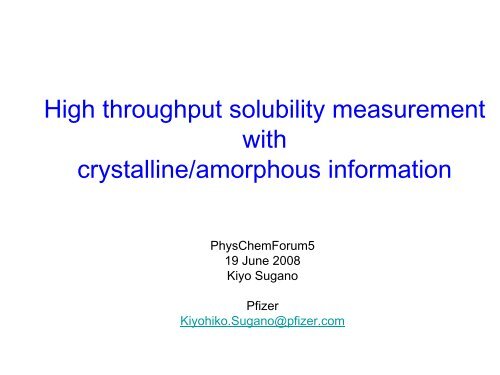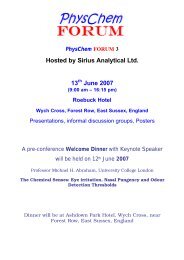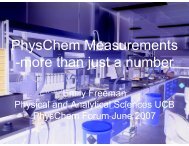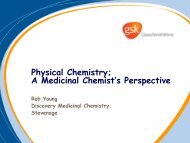High throughput solubility measurement with crystalline/amorphous ...
High throughput solubility measurement with crystalline/amorphous ...
High throughput solubility measurement with crystalline/amorphous ...
You also want an ePaper? Increase the reach of your titles
YUMPU automatically turns print PDFs into web optimized ePapers that Google loves.
<strong>High</strong> <strong>throughput</strong> <strong>solubility</strong> <strong>measurement</strong><br />
<strong>with</strong><br />
<strong>crystalline</strong>/<strong>amorphous</strong> information<br />
PhysChemForum5<br />
19 June 2008<br />
Kiyo Sugano<br />
Pfizer<br />
Kiyohiko.Sugano@pfizer.com
Outline<br />
• Introduction of new <strong>solubility</strong> screen<br />
• Results from 1700 <strong>measurement</strong>s<br />
• Strategy to apply the new method in drug<br />
discovery<br />
• Solubility calculation for oral absorption<br />
simulation
What determines <strong>solubility</strong>?<br />
Crystalline<br />
Yalkowski’s equation<br />
logSw0 Water<br />
logSw0 = 0.8– 0.8– (m.p.-25) x 0.01 0.01 – logP logP<br />
Lattice energy Hydration<br />
Bile micelle partition<br />
Amorphous<br />
Dissociation<br />
S<br />
=<br />
⎛<br />
⎜1+<br />
⎝<br />
Henderson – Hasselbalch equation<br />
Sw Sw = Sw Sw (1+[H+]/Ka)<br />
+<br />
log P<br />
H C<br />
⎞<br />
micelles ,undissociated<br />
micelles log Pmicelles ,dissociated<br />
⋅10<br />
+ ⋅ ⋅<br />
⎟ Bile micelle<br />
Ka Cwater<br />
⎠<br />
Dressman’s equation<br />
logP logP mic,undissolved<br />
=<br />
mic,undissolved 0.74logP+2.29<br />
+<br />
[ H ] C<br />
[ ]<br />
+<br />
micelles<br />
tot<br />
S0<br />
10<br />
Ka Cwater
Traditional kinetic <strong>solubility</strong><br />
• Start <strong>with</strong> DMSO sample solution<br />
• Short incubation time<br />
• Detect turbidity by nephelometry<br />
• Precipitant is assumed to be <strong>amorphous</strong><br />
– This assumption is wrong
Kinetic <strong>solubility</strong> > thermodynamic sol<br />
• Three possible reasons<br />
– Solubilitization effect of DMSO<br />
– Short incubation time<br />
– Crystal/<strong>amorphous</strong>
New <strong>solubility</strong> assay<br />
DMSO stock<br />
1. Long incubation<br />
2. Centrifuge<br />
Filtration<br />
•LC-MS<br />
•HPLC<br />
PLM<br />
Final DMSO = 1%<br />
(little effect on <strong>solubility</strong>)<br />
Glass bottom plate
Validation using Marketed Drugs<br />
Solubility from DMSO sample (log, μM )<br />
1.0E+03<br />
1.0E+02<br />
1.0E+01<br />
1.0E+00<br />
1.0E-01<br />
Incubation: 10 min<br />
(kinetic <strong>solubility</strong>)<br />
1.0E-02<br />
1.0E-02 1.0E-01 1.0E+00 1.0E+01 1.0E+02 1.0E+03<br />
1.0E+03<br />
1.0E+02<br />
1.0E+01<br />
1.0E+00<br />
1.0E-01<br />
Incubation: 20 h<br />
1.0E-02<br />
1.0E-02 1.0E-01 1.0E+00 1.0E+01 1.0E+02 1.0E+03<br />
Equilibrium <strong>solubility</strong> from <strong>crystalline</strong> (log, μM )<br />
C rysta line<br />
P artia ly C rysta line<br />
N o C rystalO bse rve d
Concentration time profile<br />
Precipitate out<br />
Amorphous<br />
Crystalline<br />
~ 1000 fold<br />
~ 4 fold<br />
(mostly 2 fold)<br />
From powder<br />
(dissolve in, <strong>crystalline</strong>)<br />
Conc.<br />
Kinetic <strong>solubility</strong><br />
Incubation Time<br />
5 min 24 hours
Solubility Ratio: polymorphs<br />
25<br />
Solubility Ratio<br />
20<br />
15<br />
10<br />
5<br />
0<br />
0 20 40 60 80<br />
Compound Number<br />
M. Pudipeddi, A. T. M. Serajuddin. J. Pharm. Sci. 2005, 94, 929–939.
Solubility Ratio: hydrates<br />
25<br />
Solubility Ratio<br />
20<br />
15<br />
10<br />
5<br />
0<br />
0 5 10 15 20<br />
Compound Number<br />
M. Pudipeddi, A. T. M. Serajuddin. J. Pharm. Sci. 2005, 94, 929–939.
Photo of 96 well plate
Auto PLM diagnostic<br />
250<br />
Intensity – position<br />
C C’<br />
1 mm<br />
200<br />
150<br />
100<br />
50<br />
0<br />
250<br />
200<br />
150<br />
100<br />
50<br />
0<br />
0 200 400 600 800 1000 1200<br />
0 200 400 600 800 1000 1200<br />
About 85% correct against human eye observation.
Outline<br />
• Introduction of new <strong>solubility</strong> screen<br />
• Results from 1700 <strong>measurement</strong>s<br />
• Strategy to apply the new method in drug<br />
discovery<br />
• Oral absorption simulation
In real drug discovery, does it work?<br />
• In 2006, > 1600 compounds measured<br />
– All pain project compounds at lead optimization<br />
– 0.6 person x day/once a week<br />
– Semi automation (No robot)<br />
• Eye observation of <strong>crystalline</strong>/amourphous
All compounds (ca. 1700)<br />
2<br />
2<br />
2<br />
Log Solubility (μ m)<br />
1<br />
0<br />
5<br />
5<br />
0<br />
Log Solubility (μ m)<br />
1<br />
0<br />
5<br />
-1<br />
-1<br />
0 1 2 3 4 5<br />
-1<br />
1 2 3 4<br />
ACD logP<br />
Retention time (min)
Percentage of <strong>crystalline</strong><br />
precipitant<br />
Compound number Number of <strong>crystalline</strong> Crystal %<br />
All 1669 - -<br />
< 150 uM a 1219 434 36<br />
Project A a 625 248 40<br />
Project B a 341 82 24<br />
Project C a 130 73 56<br />
Project D a 85 14 16<br />
Project E a 38 17 45<br />
a Compounds <strong>with</strong> > 150 μM <strong>solubility</strong> value were excluded from the<br />
analysis due to uncertainty of crystal detection by PLM.
Three findings from 1700<br />
<strong>measurement</strong>s<br />
• Solubility of <strong>crystalline</strong> is lower than that of<br />
<strong>amorphous</strong> (Of course!).<br />
• Solubility – lipophilicity relationship is vague.<br />
– Even when the precipitant was <strong>amorphous</strong>.<br />
• Percentage of crystal differed among chemical<br />
scaffold.
Fact or Myth?<br />
• In silico is good enough for <strong>solubility</strong> and<br />
permeability. Let’s quite these assays”<br />
• Similar “Myth” is also found for oral<br />
absorption simulation<br />
• Formulation is perfect. No worry about low<br />
<strong>solubility</strong>.
Even logP/D calculation is not accurate<br />
Octanol shake flask vs in silico calculation (across all project)<br />
•Do •Do we we need need more more sophisticated calculation principle?<br />
•Even •Even logD logDcalculation is is not not accurate <strong>with</strong> <strong>with</strong> the the current current<br />
in in silico silico technology, how how <strong>solubility</strong>, Caco-2,etc<br />
prediction can can be be better better than than logD logDprediction?<br />
•With •With in in a chemical series, series, the the predictability may may be be<br />
better. better.<br />
Nagoya<br />
(Shake Flask)<br />
Alex Avdeef, Stefanie Bendels, Li Di, Bernard Faller, Manfred Kansy, Kiyohiko Sugano, Yukinori Yamauchi (Intercompany<br />
collaboration) J. Pharm. Sci., 2008, 2893-2909
Outline<br />
• Introduction of new <strong>solubility</strong> screen<br />
• Results from 1700 <strong>measurement</strong>s<br />
• Strategy to apply the new method in drug<br />
discovery<br />
• Oral absorption simulation
Low <strong>solubility</strong> compound increasing<br />
120<br />
100<br />
80<br />
60<br />
Frequency<br />
40<br />
20<br />
0<br />
2005<br />
2004<br />
2003<br />
2002<br />
2001<br />
2000<br />
1999<br />
1998<br />
1997<br />
1996<br />
1995<br />
1994<br />
1993<br />
1992<br />
1991<br />
1990<br />
1989<br />
1988<br />
1987<br />
1986<br />
1985<br />
1984<br />
1983<br />
1982<br />
1981<br />
1980<br />
1978<br />
1977<br />
1976<br />
1975<br />
Year<br />
Number of publications containing the concept "poor <strong>solubility</strong><br />
drug" as of December 2006. Carried out using SciFinder®<br />
Sugano et al., DMPK, 2007, 225-254
Solubility line-up<br />
Full fledged discovery decision point<br />
Development decision<br />
Library design<br />
Lead seeking<br />
Lead<br />
optimization<br />
Candidate<br />
selection<br />
API form<br />
optimization<br />
Formulation<br />
study<br />
FIH<br />
In silico<br />
DMSO precipitation PLM method<br />
Apparent <strong>solubility</strong> from powder material<br />
pH <strong>solubility</strong> profile/FaSSIF/FeSSIF<br />
Miniscale dissolution test/DP-system<br />
In vivo studies
Chemical modification or DDS?<br />
Does standard formulation approach work? (Milling/Salts)<br />
Is the compound suitable for DDS technique?<br />
What is possible and what is not possible?<br />
Which has higher success rate?<br />
Which is faster to clinical trial and launch?<br />
Which is less resource intensive (human, manufacture etc)?<br />
Computational<br />
simulation might<br />
help to<br />
understand this.
Outline<br />
• Introduction of new <strong>solubility</strong> screen<br />
• Results from 1700 <strong>measurement</strong>s<br />
• Strategy to apply the new method in drug<br />
discovery<br />
• Solubility data for oral absorption<br />
simulation
Scheme to calculate <strong>solubility</strong> in each GI tract<br />
Measurement<br />
Chemical structure<br />
Melting point Hydrophobicity<br />
(ΔH, ΔS melting)<br />
K sp<br />
pK a<br />
Intrinsic equilibrium <strong>solubility</strong><br />
Bile micelles water<br />
partition coefficient<br />
pH and bile conc. (Av/SD)<br />
•GI position<br />
•Fasted/fed<br />
•Species differences<br />
•Individual differences<br />
Standard HH HH equation<br />
pH pH <strong>solubility</strong> profile profile<br />
Modified HH HH equation<br />
Solubility in in the the intestinal fluid fluid at at each each GI GI position<br />
•Average value value<br />
•Individual differences<br />
Sugano et al., DMPK, 2007, 225-254
Glomme, A.; März, J.; Dressman, J.,. In Pharmacokinetic Profiling in Drug Research, Testa, B.; Krämer, S.;<br />
Wunderli-Allenspach, H.; Folkers, G., Eds. Wiley-VCH: Zurich, 2006; pp 259-280.<br />
Avdeef, A.; Box, K. J.; Comer, J. E.; Hibbert, C.; Tam, K. Y.,. Pharmaceutical Research 1998, 15, (2), 209-215.<br />
Modified Henderson-Hasselbalch equation<br />
10<br />
Buffer<br />
NaTC 7.5 mM, TC/PL = 4:1<br />
<strong>solubility</strong> (mg/mL)<br />
1<br />
0.1<br />
0.01<br />
Dipyridamol<br />
Buffer HH<br />
HH for Biorelavent media<br />
Using Buffer HH for<br />
biorelevant media<br />
0.001<br />
3 4 5 6 7 8<br />
If FaSSIF <strong>solubility</strong> (at pH<br />
6.5) was used to calculate<br />
the pH <strong>solubility</strong> profile<br />
using the standard HH<br />
equation, <strong>solubility</strong> at low<br />
pHs would be over<br />
estimated. Please check<br />
your program simulation.<br />
pH<br />
+<br />
+<br />
[ H ] C<br />
log P [ H ]<br />
⎛<br />
micelles<br />
C<br />
micelles ,undissociated<br />
micelles<br />
S<br />
⎜<br />
tot<br />
= S0<br />
1+<br />
+ ⋅10<br />
+ ⋅ ⋅10<br />
⎝ Ka Cwater<br />
Ka Cwater<br />
log P<br />
− log P ≈ 1 Base<br />
log P<br />
micelles,undissociated<br />
micelles,undissociated<br />
− log P<br />
micelles,dissociated<br />
micelles,dissociated<br />
≈ 2<br />
Acid<br />
log P<br />
micelles ,dissociated<br />
⎞<br />
⎟<br />
⎠
Other precautions for simulation<br />
• pH change at solid surface<br />
• Bile micelles diffusion coefficient<br />
• Free fraction? Or drug in bile micelles absorbed?<br />
• Precipitation<br />
• GI fluid volume<br />
• Hydrodynamics<br />
• Species differences of bile conc<br />
• …<br />
• …<br />
I will discuss these items at this British Pharmaceutical Conference @ Manchester.<br />
Please come and see me again!!!
Conclusion<br />
• The new <strong>solubility</strong> assay is a beneficial asset for drug<br />
discovery.<br />
• Crystalline/<strong>amorphous</strong> information is important for<br />
drug design and compound selection.<br />
• Strategic approach is required to fix the low <strong>solubility</strong><br />
issues.<br />
– Computational simulation might help.<br />
• The modified HH equation is required for oral<br />
absorption simulation<br />
– There are many other precautions for simulation
Acknowledgement<br />
• Pfizer Nagoya members<br />
– Teruhisa Kato (Sandwich at present)<br />
– Kentaro Suzuki<br />
– Shiho Torii<br />
– Arimichi Okazaki<br />
– Atsushi Omura<br />
– Takashi Mano (Sandwich at present)<br />
• Pfizer Sandwich members<br />
– Michael Cram<br />
– Richard Manley<br />
– Hurst Kelly






